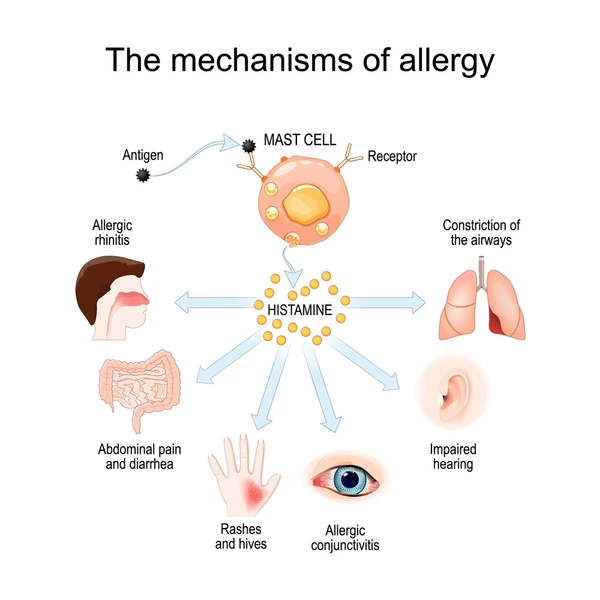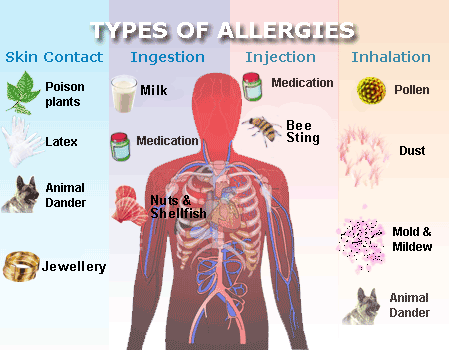This article will cover the best homeopathic remedies for allergies, causes of allergies, symptoms, risk factors, management & complete treatment.
For most of us, springtime means sunshine, green grass, and blooming flowers. But for some, it can also mean sneezing and watery eyes, or even trouble breathing.
We will talk about allergies and almost anything that can cause them either grass, flowers, peanut, bee stings, drugs the list goes on and on.
An estimated 40% of the world’s population suffers from allergies and that number is on the rise.
This article will cover homeopathic remedies for allergies, causes of allergy, symptoms, risk factors, management & complete treatment.
Table of Contents
ToggleWhat are allergies?
Allergy is the reaction of our immune system against any foreign substances. It can be pollen, peanuts, the fur of pets, or any medicine.
These foreign substances are called allergens that cause allergies to sensitive people, and they develop an immune reaction that leads to allergic inflammation.
To understand allergies further, we first need to understand our immune system.
Our immune system is meant to keep us healthy, but people with allergies, tend to overreact. The immune system is made up of a complex network of cells and organs that protects us from infection.
The cells involved in our immune system is called lymphocyte or white blood cells. Lymphocytes are like monitors, traveling around our body on the lookout for antigens or foreign substances like bacteria, parasites, fungus, and viruses.
When these lymphocytes detect an antigen, they begin producing large, Y-shaped proteins called antibodies.
Humans have almost 10 billion different kinds of antibodies, and each one binds to a specific antigen, neutralizing the threat.
But the immune system of an allergic person, the lymphocytes get confused. They treat allergens like they are antigens. These allergens don’t resemble viruses or bacteria but the immune system still treats them as a threat.
When someone is first exposed to an allergen, their lymphocytes create a bunch of antibodies called immunoglobulin E, or IgE.
Everybody has IgEs and when they attach to the surface of immune cells, those cells then release enzymes that help fight infection. It is a part of a defense system that evolved to protect us from antigens like bacteria, viruses, and fungi.
When an allergic person’s lymphocytes come in contact with an allergen, their immune cells get activated and overproduce these enzymes, causing the symptoms of an allergic reaction.
There are other cells involved in our immune system called mast cells. After an allergic reaction, the mast cells produce a chemical called histamine.
Histamine dilates blood vessels and increases the production of mucus, allowing infection-fighting cells to travel to an affected area and then the allergic person experiences varied symptoms like runny nose, sneezing, watery eyes, and in some severe cases, it can trigger an anaphylactic shock.

Types of Allergic reactions
There are 4 types of allergic reactions.
1. Immediate (type I)
This is the type of allergic reaction in which the symptoms appear after seconds or minutes of exposure.
In this type of reaction, IgE antibodies are released by the immune system in response to an allergen.
The anaphylactic reaction is the most severe one.
2. Cytotoxic (type II)
In this type of allergic reaction, the symptoms appear after minutes to hours of exposure to allergens.
The IgM and IgG antibodies are produced by the immune system which damages the cells by activating the complement system.
This type of reaction generally develops autoimmune diseases such as Autoimmune hemolytic anemia, Graves disease, Myasthenia gravis, etc.
3. Immune complex-mediated (type III)
In this type of reaction, the symptoms appear after several hours of exposure.
The antibodies react with allergens and form an immune complex such as in SLE (Systemic lupus erythematosus).
4. Delayed hypersensitivity (type IV)
When the symptoms appear after 2 to 3 days of exposure, then it is known as delayed hypersensitivity.
It develops long-term infectious diseases such as Tuberculosis and Fungal infections.
Types of Allergies
1. Food allergy
It is an allergic reaction to food or substance in food. Some people have allergies to legumes, some are allergic to milk and eggs.
2. Dust allergy
Allergy due to dust, pollen, mites, and hair of animals.
3. Skin allergy
Skin allergies like hives (raised itchy bumps on the skin) also known as urticaria, Contact dermatitis due to contact of skin with an allergen, Atopic dermatitis, or eczema due to exposure to an allergen which causes itchy dry red skin.
4. Allergic rhinitis
This is the most common type of allergic reaction also known as hay fever. This type of allergy occurs due to airborne pollen, dust mites, animal fur, and fungal spores.
5. Insect allergy
Allergy due to bee stings, cockroaches, mosquito bites, and bedbugs.
6. Drug allergy
Allergic reaction due to intake of any drug in pills, liquids, or injectable form comes under this type of allergy.

Causes of Allergy
Allergy is caused due to the abnormal response of our immune system against the allergen. It makes antibodies against it and when an allergic person comes in contact with these allergens, the antibodies recognize them, take actions against them and the symptoms develop.
Symptoms of Allergy
The symptoms of allergy depend on the substance involved. It can range from mild to severe. The symptoms are as follow-
- Sneezing
- Runny, stuffy nose
- Watery, red, swollen eyes
- Tingling in the mouth
- Swelling of the lips and tongue
- Sore throat
- Violent cough
- Itching or hives all over the body
- Skin rashes
- Swelling of the exposed part
- Dizziness, fainting, and weak pulse
- Pain and redness in the exposed part
- Difficulty in breathing
- Shortness of breathing
- Profuse sweating
- Stomachache
- Nausea and vomiting.
Risk factors of allergy
Children are more likely to develop an allergic reaction due to weak immune systems.
If you have any family history of allergies like eczema, hay fever, or hives then you can develop an allergy.
The chances of allergy become high if you have asthma or any other allergic condition.
Diagnosis of Allergy
Allergies can be diagnosed by signs and symptoms and their timing of appearance, however, there are various tests are available to confirm the diagnosis of allergies.
Diagnosis of allergies begins with a physical examination after taking the full case, including medical and family history. The physician will then analyze the case and evaluate the condition thoroughly.
There are various lab tests also available for diagnosis such as-
Blood testing, to detect IgE antibodies to specific allergens in the blood
Skin testing, by prick/puncture procedure. In this, a scratch is made in the skin and a specific antigen is placed to see the allergic reaction.
Another test includes patch testing, in which patches with a small amount of allergen are placed over the skin and kept there for two days to see if any reaction occurs.
Prevention and management of Allergy
Eliminate the irritating agents from surrounding whether it is food, pet fur, pollen, or any medication to reduce the risk of allergy.
Avoid damp housing conditions and reduce indoor air pollutants.
Infants having cow’s milk allergies should avoid cow’s milk protein. If a supplement is needed, use a hypoallergenic formula to improve symptoms control.
Wash pillows and bedding regularly in hot water to decrease the risk of allergy.
Do not allow pets in the bedroom.
Eradicate cockroaches with appropriate insecticides.
Wear a mask over the nose and mouth to prevent inhalation of dust, pollen, or any airborne allergens.
Take a lukewarm bath.
The Most important self-care measure is to avoid scratching. Scratching can lead to further inflammation and damage to the skin.
Apply a mild moisturizer to the affected part and use mild perfume-free soap to prevent dermatitis.
Keep the antihistamine drugs handy and in case of exposure to allergen take the drug but avoid overdosing.
Best Homeopathic Remedies for Allergies
Allergies are considered to be an immune-mediated condition which means that the origin is from within the body. Hence the treatment should also involve the internal process, which is only possible in homeopathy.
Hence, homeopathy will help alter the body’s immune mechanism and help reduce the intensity and frequency of the allergic reaction. That is, the condition is uprooted from the root cause and not superficially by applying local ointments.
The duration of treatment will depend upon the severity of the allergic reaction. In mild cases, improvement can be seen in 4-5 weeks, whereas severe cases will take a longer time.
Now, let’s go through some of the homeopathic medicines that can help to treat allergies.
Some of the best homeopathic medicines for the treatment of allergies are mentioned below.
- Allium Cepa
- Apis Mellifica
- Arundo Mauritanica
- Arsenicum Album
- Causticum
- Dulcamara
- Euphrasia Officinalis
- Gelsemium Sempervirens
- Histaminum
- Natrum Muriativum
- Sabadilla
1. ALLIUM CEPA: for acute catarrhal inflammation of mucous membranes
The symptoms include – burning in the eyes with excessive lachrymation.
This medicine is indicated for profuse coryza with acrid nasal discharge, that burns and corroded nose and upper lip.
Dosage and potency: 30c, 200c 4 globules (pills) dissolved in half cup of water 3 times a day.
2.APIS MELLIFICA: for skin allergies with stinging and burning pain
This medicine is best suited for urticaria or hives, in which the affected part becomes red and gets swelled up with stinging and burning pain.
Pain migrating from one part to another.
Apis is also very effective in treating diarrhea to suppressed eruptions.
There is incontinence of urine with great irritation in the urinary tract of the patient.
Apis is also a beneficial remedy for treating oedematous swelling of the hand and feet without thirst.
Dosage and potency:- 200c, 4 globes in half cup of water thrice a day till the symptom disappear.
3.ARUNDO: for allergic rhinitis and runny nose
This medicine is best suited for catarrhal states, where there is itching in the palate (roof of the mouth) and burning in the nostrils. There is also burning coryza with the sense of smell becomes diminished.
There is burning and itching in the auditory canal of the ear with eczema behind the ear pinna.
Arundo is also suited for treating respiratory problems like painful breathing (dyspnoea), catarrhal cough with bluish sputa, and bronchitis.
Dosage and potency: 30c, 200c, take 4 drops of dilution in half cup of water twice a day, till the improvement is seen.
4.ARSENIC ALBUM: for food allergies whether by olfaction or ingestion
This medicine is indicated for food allergies. The patient becomes anxious, irritable, and restless.
Patients feel nauseated with the smell of food, they can’t tolerate the smell of food.
They have an intense thirst for cold water but drink only a little at a time. This is the marked characteristic of patient’s symptoms who need this medicine.
Dosage and potency: 200c potency take 4 globules (pills) twice a day till the improvement occurs.
5.CAUSTICUM: for catarrhal cough with the inability to expectorate
Causticum is a wonderful remedy for the relief of symptoms of allergies.
The symptoms include, runny nose, sneezing, itching in the nose and throat due to allergic rhinitis of the upper respiratory tract.
There is a cough with soreness in the chest and the patient can’t able to expectorate the mucus, sputa must be swallowed.
Causticum is also indicated where there is hoarseness of voice and sometimes aphonia (inability to speak due to disease in the larynx) which gets worse in the morning.
Dosage and potency: 200c potency of dilution, take 2-3 drops in half cup of water twice a day, till the symptoms disappear.
6.DULCAMARA: for allergies due to a sudden change in weather, from hot to cold
Dulcamara is best suited for those patients who live or work in damp, cold basements. Such people have a high risk to develop catarrhal affections and asthma.
This remedy helps treat asthma and shortness of breath.
Dulcamara is indicated when there is increased secretion of mucous membranes such as runny nose, watery eyes, and offensive perspiration.
Sometimes there may be seen complete blockage of secretion such as nose block and suppressed perspiration after taking cold.
This remedy is also indicated in catarrhal ischuria in grown-up children due to wading with bare feet in cold water or mud.
Dosage and potency: 200c potency, take 2-3 drips of dilution in half cup of water and take twice a day till the improvement.
7.EUPHRASIA: for profuse Madrid lachrymation and bland coryza
This medicine is best suited for allergic rhinitis, where the eyes water all the time.
Eyes become red and swollen due to acrid lachrymation with a burning sensation in the eyes.
There is profuse, frequent coryza in the morning with a violent cough which get aggravated by warmth.
It is useful in treating respiratory disorders such as throat infections and cough.
An offensive mucus is expectorated when the patient attempts to clear his throat.
Dosage and potency: 30c, 200c, 4 globules (pills) twice a day till the improvement is seen.
8.GELSEMIUM: for people having the nervous and hysterical temperament
This medicine is very effective in treating dust and drug allergies.
Gelsemium is indicated when there is anticipation, nervousness, and excitement is seen in the patient.
There is marked dullness, dizziness, drowsiness, weakness, and trembling of tongue and whole body that give indications to this medicine.
This remedy is best suited for ptosis that is drooping of eyelids, the patient feels the heaviness of the eyes and can’t keep them open.
The condition of Gelsemium patients becomes worse in damp weather and before a thunderstorm.
Dosage and potency:- 200c potency, take 4 globules thrice a day up to improvement.
9.HISTAMINUM: for histamine allergic reaction
This remedy is best suited for the allergies caused due to bee stings.
There is a redness and burning sensation in the affected part of the skin.
Histaminum is indicated when there is pruritus or uncontrollable itching and burning sensation in the nose, throat, ears, and vagina.
The patient becomes irritable, susceptible, impatient, and needs to walk up and down.
It is also effective in many respiratory diseases like bronchial asthma, nasal congestion, and whooping cough.
Dosage and potency: 30c, 200c take 3-4 drops of dilution in half cup of water twice a day.
10.NATRUM MUR: for dryness of mouth and thin watery discharge from the nose.
This remedy is suggested for allergic rhinitis or hay fever due to exposure to the sun or intense summer heat.
There is marked violent sneezing, with thin watery coryza like white of an egg.
Patients have craving for salts and a great aversion to bread.
There is profuse lachrymation, tears stream down the face whenever the patient coughs.
It is also an effective remedy for treating acute and chronic urticaria of the whole body, especially after violent exercise.
Dosage and potency: 200c potency, take 4 globules under the tongue, twice a day for 15 days or until the improvement appears.
11.SABADILLA: for sneezing in spasmodic paroxysms
Sabadilla is one of the best remedies in treating allergic reactions due to dust.
The symptoms mainly include copious watery coryza, redness, and burning in the eyelids.
These patients are sensitive to colds and develop cough and sneezing frequently.
Sabadilla is effective in treating violent coughing attacks, sore throat, asthmatic breathing, wheezing respiration, dry cough with perspiration, and water in the eyes.
There is itching in the soft palate and can’t bear anything cold and hot in the mouth. Also, there is dryness of the mouth without thirst.
Dosage and potency: 200c, take 2-3 drops of dilution in half cup of water thrice a day till the symptoms disappear.
Remember that homeopathic remedies are prescribed based on individual symptoms and characteristics. It’s crucial to consult with a qualified homeopath for proper evaluation and personalized treatment. Homeopathy focuses on treating the whole person, so a detailed case study is necessary to select the most appropriate remedy.
Homeopathic medicines should be taken only when prescribed by a homeopathic physician. Self-medication may aggravate the original conditions.


2 thoughts on “Top 10 Homeopathic Remedies for Allergies- Symptoms & Cure”
बहुत सुंदर लिखा है, अचूक जानकारी दिया आपने। धन्यवाद।।
Hi your blog is worth appreciating and it has a lot of useful information.
Healvibe Healthcare Has Integrative Treatment Approach That Integrates Different Systems Like Homeopathy, Physiotherapy, Acupressure And Acupuncture, Nutrition And Dietetics, Psychotherapy And Psychological Counseling.Our Main Focus Is On Health Promotion, Early Intervention Of The Disease And The Treatment Of Illness. Our Integrated Approach Towards The Patient’s Complaints Helps The Patients To Get Rapid And Gentle Cure. We believe in treating the patient in a Holistic manner.
For more information visit our website : https://healvibe.care/